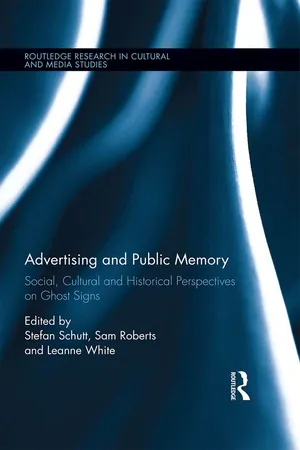Existing Literature
No scholarly books on ghost signs currently exist, although a number of Dutch and Belgian publications have tackled ghost sign-related historical research. These include Collet et al.’s De la pub plein les murs (2010), a historical account that positions Belgian signs in the context of social, craft and advertising history, and Havelaar and Hijhof’s Tekens Aan De Wand (2012), which documents the restoration efforts of local historical societies throughout the Netherlands.
Perhaps the first scholarly article specifically about ghost signs was published in 2007 by the Literary London journal (Roberts and Groes 2007). A trickle of further articles have appeared since, especially in recent years (see Shep 2015; Cianci and Schutt 2014; Sinfield 2014).
However, popular works have long been written about ghost signs and related areas, as well as heritage reports and policy documents. Some locally relevant documents are cited in the chapters by Australian heritage professionals Leisa Clements (Chapter 17) and Rachel Jackson (Chapter 19), Belgian heritage professional Veerle De Houwer (Chapter 18) and US-based educator Marie Wong (Chapter 20). Additionally, Waller and Waller provide case studies of Australian heritage processes involving ghost signs in Chapter 21.
Popular literature on ghost signs began in the United States. The first popular book to deploy the term ‘ghost signs’ is writer and photographer William (‘Wm’) Stage’s 1989 book of the same name, which documents a number of American signs. Passikoff’s 2006 The Writing on the Wall: Economic and Historical Observations of New York’s “Ghost Signs”, offers analyses of ghost signs that are related to the economic development of New York. Also based in New York, educator and ghost sign expert Frank Jump began to document signs in the 1990s: Jump’s 2011 Fading Ads of New York City contains a photographic essay as well as written commentary on meaning and place as they relate to the signs. Most other popular ghost sign books, which tend to originate from the US, UK and Europe, focus on documenting signs within specific locales. Although not printed publications, it is also important to mention digital initiatives such as the influential UK-based History of Advertising Trust Ghostsigns Archive, an online archive established by book editor Sam Roberts in 2010 and discussed by Laura Carletti in Chapter 5. Other significant digital projects have also taken place in Europe, such as the Roadside Advertisements initiative, which has been documenting signs in France and Belgium.1
Works on related topics precede the publication of the first ghost sign books. In terms of advertising and branding, Cozzolino and Rutherford’s 1980 work Symbols of Australia provides an exhaustive overview of 1700 household brands known to Australians. In Chapter 14, leading UK advertising practitioner and commentator David Bernstein outlines the connections between painted and outdoor billboard and poster advertising, citing important volumes from this field such as Dunn’s Advertising: Its Role in Modern Marketing, first published in 1961, and his own Advertising Outdoors (1997). A number of theoretical advertising texts also intersect with aspects of ghost signage, including Judith Williamson’s 1978 Decoding Advertisements, which explores the appeal of advertising and investigates how advertisements assume meaning. Within this volume, themes connected with branding and advertising are explored by Robert Crawford in Chapter 12.
From a graphic design perspective, Baines and Dixon’s 2003 Signs: Lettering in the Environment, takes a comprehensive look at forms of public lettering. Stephen Banham’s Characters: Cultural Stories Revealed through Typography (2012), adopts a narrative approach to public lettering by focusing on the stories and people behind a number of iconic Melbourne signs, including painted and neon signs. Related publications focus on what has been deemed commercial or industrial archaeology (Connerton 2009), at times within the discipline of cultural geography (see, for example, Hill 2013) or within archaeology itself, such as Harrison and Schofield’s After Modernity: Archaeological Approaches to the Contemporary Past (2010). However, commercial archaeology organisations have been around for much longer, such as the US-based Society for Commercial Archeology, promoted online as ‘devoted to preserving the 20th century commercial landscape since 1977’.2
Recent years have also seen a resurgence of interest in signwriting, coinciding with the growth of interest in the handmade and ‘bespoke’. As a result, a signwriting-focused literature is emerging, as evidenced by the popular Sign Painters documentary and accompanying book (Levine and Macon 2012); see Chapter 6 by Schutt and Mead for more on this.
Last, a body of urbanist literature has its origins in Lefebvre’s (1968) notion of Le Droit à la ville, or ‘right to the city’ – the right for ordinary city dwellers to gain agency over their environment through everyday activities such as exploring on foot. As well as the intersecting concepts of the Situationists, this tradition has continued in the work of theorists including David Harvey and Michel de Certeau, who sees citizens’ everyday appropriation and subversion of rules created by authorities as a form of resistance (1984). This approach has been critiqued as an ineffective watering down of the original collectivist, activist intention of the Droit à la ville (Ross 2009; Soja 2010), and others have challenged the notion of a transparent and inclusive ‘everyday life’ (Highmore 2002).
Nevertheless, practices of novel urban discovery have seen an upsurge during recent years. A combination of scholarly and popular literature is developing on related themes, including Oli Mould’s Urban Subversion and the Creative City (2015), Colin Ellard’s Places of the Heart: The Psychogeography of Everyday Life (2015) and Sarah Pink’s Situating Everyday Life: Practices and Place (2012). Echoes of this approach to urban life can be witnessed in the activities of some ghost sign aficionados (Schutt 2016). One prominent example is the aptly named and aforementioned Frank Jump, who has taken many of his best New York ghost sign photographs by climbing, unauthorised, over fences and onto roofs.
